Timing, instructions and diagrams for pruning an apple tree in the fall for beginners
Proper care of the apple tree and the creation of optimal conditions will ensure its normal development and good fruiting. At the same time, pruning is one of the important and main points when growing crops. Let's look at how to prune apple trees in the fall and what schemes are available.
Fall pruning goals
Autumn pruning is a necessary procedure that is carried out annually throughout the entire life cycle of the plant.. Her goals:
- formation of a healthy and beautiful crown;
- increasing productivity;
- increasing the size of fruits, improving their taste;
- longevity of culture;
- strengthening branches;
- correct distribution of light flux in the crown;
- normalization of natural air exchange in deciduous trees;
- prevention of fungal and bacterial diseases;
- preparing the tree for winter and increasing frost resistance;
- facilitating work related to care and harvesting.
Neglecting pruning can result in the tree becoming neglected and weakened.. The harvest will be reduced and the fruits will be crushed.
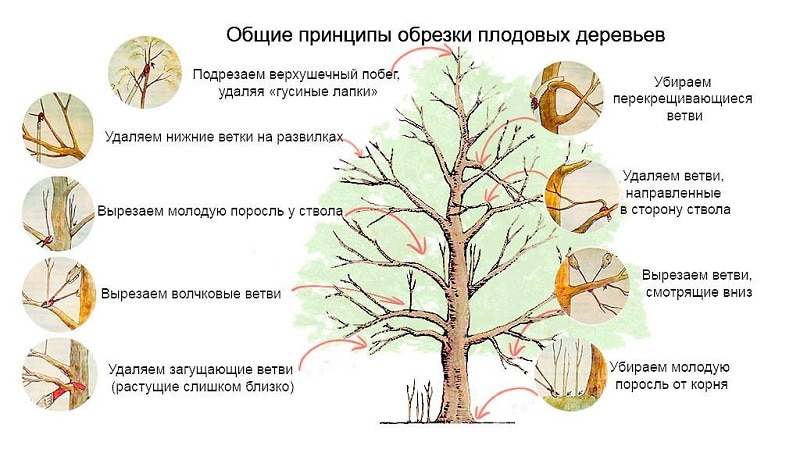
When to prune apple trees in the fall
Beginning gardeners often wonder when to prune and in what month is the best time to do it. The specific date depends on weather conditions in the current year..
Reference. The universal signs that allow you to start pruning are yellowing and complete loss of foliage. This indicates the cessation of sap flow in the trunk and branches.
For pruning, choose a clear and dry day 2-3 weeks before frost.This period is required for wound healing, tissue regeneration and preventing the negative effects of frost.
Features of autumn pruning
Autumn pruning is a good way to strengthen and prepare the plant for spring.. It is important to pay attention to some features of its implementation:
- It is advisable to minimize the amount of damage caused: it is better to cut one larger branch than many small ones;
- Thick branches with a diameter of 10 cm or more are not recommended to be pruned in the fall; it is better to do this in the spring;
- Process sections of fresh shoots only after they have dried (after about a day), dry branches - immediately.
Preparation
Before you start pruning a tree, it is important to carry out preparatory work:
- determine the condition of the apple tree: its age and development, crown size;
- choose a pruning scheme in accordance with the condition of the tree;
- inspect for the presence of pests and diseases, treat damage to the bark with antibacterial solutions (for example, copper sulfate);
- prepare tools and materials.
How to prune apple trees in the fall
Pruning is important for the growth and development of the plant. It strengthens and stimulates the culture, but only if all the rules are followed when executed.
Required materials and tools
To prune a fruit crop, you will need the following tools and materials:
- garden saw for cutting thick branches;
- pruning shears for removing branches and twigs;
- garden knife for trimming bark on cuts;
- ladder or stepladder if the tree is tall;
- garden varnish or paint for processing saw cuts;
- gloves and thick clothing with long sleeves to avoid scratching your hands.
Advice! Before work, check the tools for functionality, sharpen if necessary, and disinfect.
Step-by-step instruction
Autumn pruning is carried out in stages:
- Clean the trunk circle from fallen leaves and dry branches.
- Place boards under the crown. You can stand on them yourself or put a stepladder if the apple tree is tall. This will prevent the soil from compacting.
- Proceed with removal dry, injured, damaged branches, which are more susceptible to freezing in winter than others.
- Remove branches, growing inside the crown and disrupting light and air exchange.
- Trim the tops - shoots that grow upward do not bloom or bear fruit.
- Find competing branches, which grow in one direction and close to each other. Select and cut off the weakest ones.
- Delete branches, growing at an angle of less than 45°. If the harvest is good, they will not withstand the load and will break off.
- Cut out young shoots at the trunk and from the root.
- Shorten branches, giving the desired shape to the crown.
- Trim the apical shootso that the tree does not stretch too much in height.
- Process the sections garden varnish or paint.
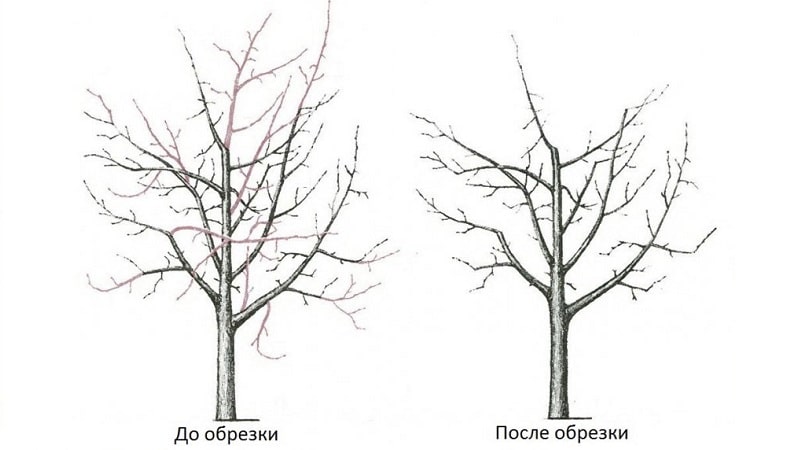
For sanitary purposes, cut branches are removed immediately from under the tree, taken out of the area and burned.
Interesting things on the site:
Feeding apple trees correctly in the fall
How to plant an apple tree in the fall and how to do it correctly
Mistakes to Avoid
When pruning a fruit plant It's important to avoid some mistakes:
- immediately treat fresh cuts with garden varnish, without allowing them to dry out;
- do not process sections, which can lead to infection;
- carry out pruning without taking into account the weather;
- use tools that have not been disinfected;
- use blunt instruments, which leads to torn cuts and damage to the bark - the cuts will not close well, and infection can get through the damaged bark;
- leaving a large stump when cutting a branch, which begins to rot over time;
- clean the hollows that appear after pruning until they reach healthy tissue - just cover them with clay or foam.
It is not enough to carry out the procedure once. Her performed every season, because the tree must be under constant supervision.
Possible schemes for pruning apple trees in autumn
There are various schemes for autumn pruning of apple trees. The choice of a specific one depends on the age and condition of the tree, but they are all similar in the standard principle of implementation: pay attention to thinning, opening the center and adjusting the height.
For rejuvenation
This pruning rejuvenates the trees and makes it easier for them to winter, prevents the development of diseases and pests, stimulates the awakening of dormant buds.
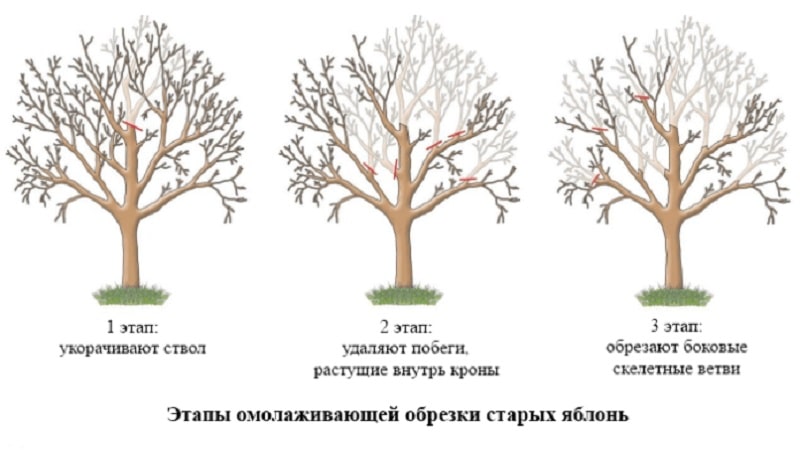
Provides for cleaning the crown from thickening, sagging and old branches, removing tops, opening the center and trimming the center conductor to reduce the height of the plant.
Reference. Anti-aging pruning can renew the growing season of old but valuable varieties of apple trees.
For fruit crops older than 5 years, regular anti-aging pruning is required.. It is usually carried out once every 2-3 years.
To form
Formative pruning gives the crown a certain shape and helps maintain it, strengthens the skeletal part of the plant and increases resistance to stress.
Reference. For young trees, exclusively formative pruning is suitable. After the seedling takes root, it is used for the first 5 years.
The procedure involves removing shoots growing inside, shortening the branches along the edges of the crown and giving it the desired shape, trimming the central conductor to regulate the height of the tree.
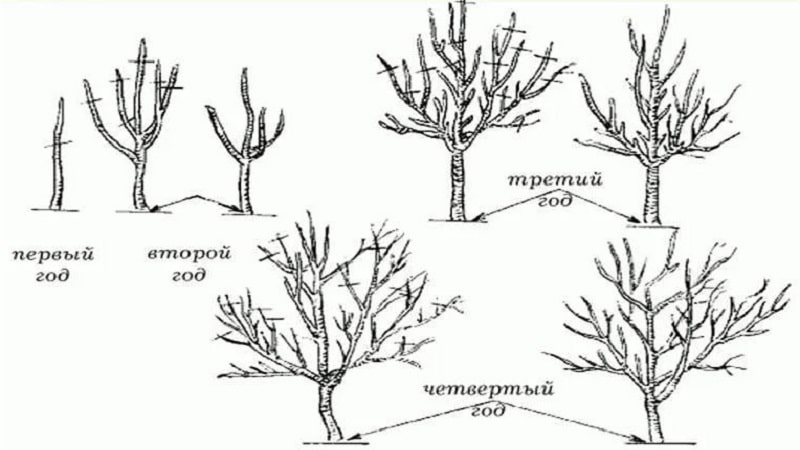
Universal
There are a number of universal trims that suitable for apple trees of any age:
- sanitary - pruning of dry, broken and disease-affected branches;
- restorative - puts the crown in order after mechanical damage, frostbite, fire, wind;
- structural - carried out to remove small and medium branches if they interfere with the main ones.
Annual pruning is called maintenance., which, depending on the state of the plant, may include all of the listed schemes.
Schemes and nuances of pruning for different growing regions
The growing region does not directly affect the patterns and nature of plant processing. The peculiarity lies in the timing of its implementation, which is based on the climatic conditions of a particular area:
- Moscow region and middle zone: mid-October – early November;
- Leningrad region: mid-September – late October;
- southern regions of Russia: end of October – 3rd ten days of November;
- Ural and Siberia: late September – early October.
In cold regions, it is permissible to prune early and mid-season varieties in the fall. It is better to postpone pruning late varieties until spring, when the risk of return frosts has disappeared.
Read also:
For old and young trees
If an apple tree is 20 years old or more, it is considered old. Its yield decreases and the quality of the fruit deteriorates. To restore the tree, it is rejuvenated by deep pruning. Key points of the procedure:
- Removal all dry and damaged branches.
- Cutting all branches growing inside the crown, vertical shoots located close to each other.
- Shortening lateral skeletal branches.
- Circumcision trunk at a height of 3–3.5 m.
Rejuvenation takes place over several years, since severe pruning of neglected plants at one time can lead to their death.
Pruning a young apple tree is carried out in stages, starting with planting the seedling in the main place:
- Annual seedling without branches, they are shortened at a height of 80 cm from the surface of the earth to grow shoots, which in the future will become skeletal.
- In a two-year-old plant form a skeleton by removing excess branches. Only 2-3 strong side branches are left, which are cut to 1/3 of the length.
- For 3 years thin out the crown. Last year's branches are left, new ones are cut off by 1/3. Shoots growing downward and at an acute angle are removed.
- For 4 years repeat the work carried out in the 3rd year of the plant’s life. Thickening branches are cut off.
From the 5th year of life, cultures are carried out annually shaping and sanitary pruning.
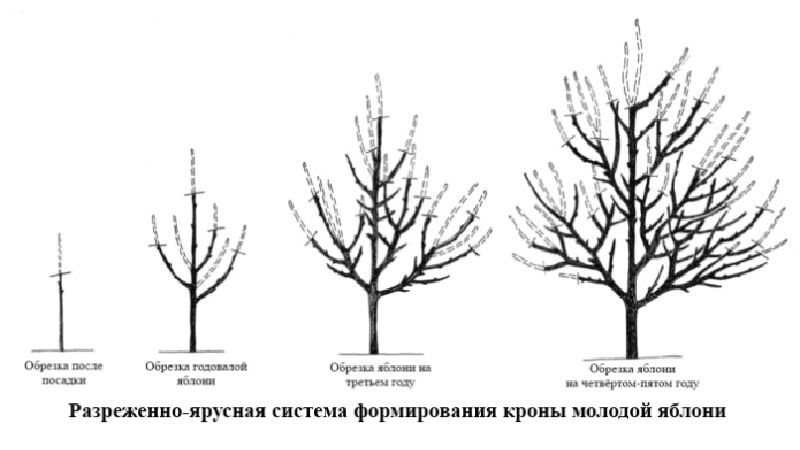
For columnar apple trees
Columnar apple trees do not have significant lateral branches; they do not have a wide and massive crown. Taking into account this feature highlight some nuances of autumn crop pruning:
- You can't cut off the top, otherwise the side shoots will begin to actively grow, and the apple tree will look like a dwarf variety.
- Shorten annually young shoots. Usually 3-4 buds are left and the rest of the branch is cut off.
- Be sure to thin out by removing old, thickening, weak branches. The crown is prone to thickening, which is why the fruits become small.
If the procedure is performed correctly, the annual growth of the apple tree will be 10–15 cm.
For dwarf varieties
For dwarf varieties It is especially important to form the crown correctly: This is the only way to ensure stable and high yields.
Reference. Preferably formative and sanitary pruning is carried out.
The formation rules are the same as for vigorous plants, but in a shorter time.. As a result, in the fourth year, a tree is obtained no more than 2.5 m high with an average branch length of about 1 m.
Sanitary pruning with removal of old, diseased, dry branches It is held twice a year: in spring and autumn.
Further care
After the procedure the tree needs care, which consists of a number of activities:
- cleaning the trunk of mosses and lichens with a plastic spatula and treating with copper sulfate (500 g per bucket of water);
- moisture-charging watering, ensuring abundant flowering in spring and fruiting (for an adult apple tree you will need 4–6 buckets of water, the ground should be moist to a depth of 1 m);
- fertilization: 1-2 buckets of rotted manure, 50 g of superphosphate;
- digging the soil to a depth of 15 cm;
- mulching: cover the tree trunk circle with a thick layer (up to 15 cm) of peat, pine needles, moss or chopped tree bark;
- whitewashing the trunk in late autumn.
To protect against insects and other pests, winter treatment is carried out. drugs (“Aktara”, “Aktellikom”, etc.).
Useful tips
Useful tips from experienced gardeners:
- regularly inspect the cuts after circumcision; you may need to re-treat them with garden varnish;
- trim no more than 1/3 of the crown even if the tree is in a neglected state (in the latter case, it is better to divide the procedure into several seasons);
- whitewash the tree trunk with chalk before it is five years old, and then with lime;
- wrap the trunk with burlap to insulate and protect the bark from hares and rodents;
- make a support next to young trees to protect from strong winds.
These measures will allow the work to be carried out as gently as possible for the plant., which will have a positive effect on its condition and fruiting.
Conclusion
Autumn pruning is an important stage in caring for fruit crops, especially apple trees. It affects the development of the plant, readiness for winter frosts, fruiting, promotes the formation of the crown and rejuvenation of the crop.
It is important to remember that cutting is stressful for the plant. When carrying out it, it is recommended to take into account weather conditions, use sharp tools, process cuts, and then properly care for the tree. Only then will pruning be as useful as possible.